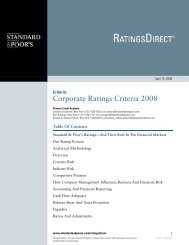European Infrastructure Finance Yearbook - Investing In Bonds ...
European Infrastructure Finance Yearbook - Investing In Bonds ...
European Infrastructure Finance Yearbook - Investing In Bonds ...
You also want an ePaper? Increase the reach of your titles
YUMPU automatically turns print PDFs into web optimized ePapers that Google loves.
UTILITIES<br />
20 ■ NOVEMBER 2007<br />
• For TVO, a strong turnkey, time-certain<br />
supply contract with ample guarantees,<br />
backed by strong suppliers and security<br />
bonds in the construction phase, as well as<br />
by offtake agreements with its main<br />
shareholders during the operation phase.<br />
• For EDF, during the construction phase by<br />
the group’s expertise in building nuclear<br />
plants, its last such plant in France having<br />
been commissioned in 2002, and by the<br />
group’s leading domestic position and the<br />
protective French regulatory environment in<br />
the operation phase.<br />
• For the Slovakian plants by the strong<br />
support of the government, which owns<br />
34% of SE.<br />
From a financial perspective, both EDF and<br />
Enel have the financial flexibility to carry out the<br />
investments necessary for their new builds of,<br />
respectively, € 3.3 billion and $2.2 billion. TVO is<br />
much smaller, but the protective turnkey contract<br />
and the offtake arrangements with its major<br />
shareholders provide substantial comfort.<br />
That said, in August 2007 we revised to<br />
negative the outlooks on Estonia-based integrated<br />
electric utility Eesti Energia AS (A-/Negative/--)<br />
and Lithuania-based electricity transmission<br />
company Lietuvos Energija (A-/Negative/A-2) to<br />
reflect the risks stemming from their possible<br />
participation in a prospective new nuclear power<br />
plant at Ignalina, Lithuania.<br />
The Ignalina nuclear project is based on a 2006<br />
agreement between the governments of Lithuania,<br />
Estonia, Latvia, and, at a later stage, Poland.<br />
However, realization of the project, including<br />
funding, will be the responsibility of the<br />
participating state-owned power companies. Eesti<br />
Energia could participate in the nuclear project<br />
with a 22% stake, while Lietuvos Energija would<br />
have a 34% stake and would be responsible for<br />
the plant’s operations. The nuclear power plant<br />
would have maximum installed capacity of 3,400<br />
MW at a projected cost of up to €4 billion.<br />
Extension Of Existing Plants Would Be<br />
Credit Positive<br />
A number of EU nuclear operators are seeking to<br />
extend the operating life of their plants drawing<br />
on the U.S. example, where at the end of 2006,<br />
47 licenses extending the operating life of nuclear<br />
plants to 60 years had been granted and an<br />
STANDARD & POOR’S EUROPEAN INFRASTRUCTURE FINANCE YEARBOOK<br />
additional eight were being reviewed.<br />
<strong>In</strong> the U.K., British Energy Group PLC (BE;<br />
BB+/Watch Neg/--) obtained approval in 2005 for<br />
a 10-year extension of its Dungeness plant. <strong>In</strong><br />
2008, BE may apply to extend the lives of its<br />
Hinkey Point and Hunterston plants, which are<br />
currently scheduled to close in 2011. Extending<br />
the operating life of its nuclear plant beyond the<br />
current 40 years is also a key pillar of EDF’s<br />
strategy. Czech operator CEZ a.s. (A-/Stable/--),<br />
has also launched an upgrade program at its<br />
Dukovany nuclear plant, with a view to<br />
increasing capacity by 160 MW and extending<br />
operating life by up to 20 years. Although<br />
Swedish utilities have not applied for life<br />
extensions they have obtained approval for<br />
uprates (capacity increases), which will<br />
significantly boost their nuclear capacity: Uprates<br />
underway and planned between 2006-2011 at the<br />
Ringhals plant, which is operated by Vattenfall<br />
AB (A-/Stable/A-2), will increase its capacity by<br />
close to 500 MW. The group will also boost<br />
capacity at its other nuclear plant, Forsmarks, by<br />
410 MW between 2008-10. E.ON Sverige AB<br />
(A/Stable/A-1) is also planning a 250 MW uprate<br />
of its Oskarshamn-3 reactor, to increase its<br />
capacity to 1,450 MW.<br />
We view such extensions very positively as,<br />
while running, nuclear power plants are highly<br />
cash generative in light of their low variable costs<br />
and limited capital expenditures for maintenance.<br />
Such extensions also delay decommissioning<br />
liabilities and capital expenditures for<br />
capacity replacement.<br />
Conversely, New Nuclear Build Is<br />
<strong>In</strong>herently Risky<br />
Building new nuclear plants is challenging given:<br />
• Long lead times with no offsetting revenue.<br />
EDF Energy PLC (A/Stable/A-1), which is<br />
interested in building four new nuclear<br />
plants in the U.K., believes that the earliest<br />
such a plant can be commissioned is 2017.<br />
•High upfront capital costs (about € 3<br />
billion), with the risks of delays overruns,<br />
especially for “first of a kind” plants. The<br />
TVO plant in Finland is now about two<br />
years late and has experienced very<br />
substantial cost overruns.<br />
Such features are specific to nuclear power<br />
plants, conventional power plants having much<br />
shorter lead times and much lower capital costs.



